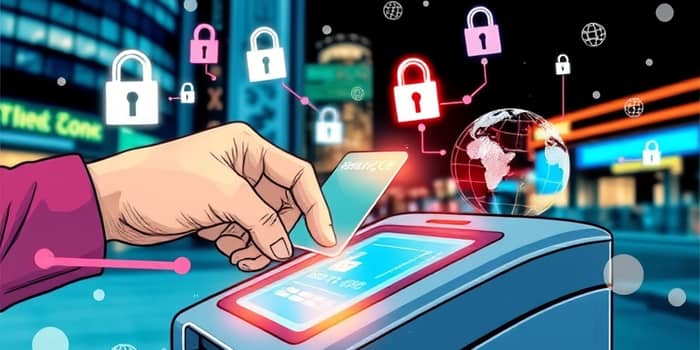Contactless payment cards have rapidly become a cornerstone of modern commerce, offering an elegant blend of speed, security, and user-friendly convenience. As individuals and businesses embrace cashless solutions, these cards stand out for their transformative potential in reshaping everyday transactions.
Introduction to Contactless Payments
The global contactless payment market was valued at $34.55 billion in 2021 and is forecast to expand dramatically in the coming decade. Consumers and merchants alike are drawn to the effortless nature of tap-and-go technology, which has swiftly outpaced traditional chip-and-PIN methods in popularity.
This shift is driven not only by technological advancements but also by changing preferences. Today’s shoppers demand instant and frictionless payment experiences that minimize delays at checkout lanes, promoting a smoother flow in retail, hospitality, and transit environments.
Key Benefits of Contactless Payment Cards
Contactless payment cards deliver a myriad of advantages that extend beyond mere convenience. They fundamentally alter how we think about financial exchanges, prioritizing efficiency, health, and trust.
- Faster transaction times than traditional methods reduce queues and improve customer satisfaction in busy venues.
- Minimizes contact with public surfaces, offering an extra layer of hygiene in high-traffic areas and reducing germ transmission.
- Less wear and tear on card readers and cards extends the lifespan of physical payment tools and lowers replacement costs.
- Global acceptance enhances travel convenience, allowing seamless purchases in airports, hotels, and retail outlets worldwide.
- Encryption and tokenization to secure every transaction, shielding consumer data from unauthorized access.
These benefits combine to create an elevated payment experience that resonates with today’s fast-paced lifestyles.
Adoption and Trends
Contactless payments have witnessed remarkable uptake across the globe. In many European and Asian markets, over 82% of in-person transactions now occur via tap-and-go cards. This adoption curve reflects a broader digital transformation in consumer behavior.
Analysts predict that by 2025, approximately 67% of all transactions will be digital, underscoring a decisive move toward a cashless society. Furthermore, more than half of U.S. smartphone users are expected to add digital payment methods to their mobile wallets, reinforcing the symbiotic relationship between hardware and financial ecosystems.
Security Measures and Consumer Confidence
Security remains a top concern in the payment landscape. Contactless cards address these worries through advanced protocols that safeguard every tap or wave against fraud and data breaches.
- Dynamic data exchange prevents replay attacks by using single-use codes for each transaction.
- Multifactor authentication options are available for high-value transactions, adding a robust second layer of protection.
- PCI Contactless Payments on COTS standards ensure that merchants adhere to rigorous security benchmarks.
By embedding these measures, contactless systems not only protect consumer information but also build trust in an increasingly digital economy.
Impact on Business Operations
For merchants, contactless payment cards translate into tangible operational advantages. Retailers, restaurants, and service providers can shave valuable seconds off each sale, leading to higher throughput during peak hours.
Reduced reliance on cash also means fewer counting errors, lower risk of theft, and diminished labor costs associated with counting and reconciling cash drawers. Over time, these improvements drive operational efficiency and cost savings that strengthen the bottom line.
In addition, data analytics derived from contactless transactions yield insights into consumer spending patterns, enabling businesses to tailor promotions and optimize inventory with unprecedented precision.
Consumer Behavior and Preferences
Modern consumers prize experiences that are not only convenient but also secure. Surveys reveal that speed of payment is among the top three factors influencing their choice of checkout method. Contactless cards fulfill this desire by delivering seamless and instantaneous finalization of purchases.
Moreover, the visible security markers—such as card icons and reader lights—reinforce user confidence. As financial literacy around digital payments grows, more users view contactless methods as their primary means of transaction, relegating cash and manual entry to secondary roles.
Future Outlook
The momentum behind contactless payment cards shows no signs of waning beyond 2025. Emerging technologies like biometric authentication and blockchain-based transaction verification promise to elevate the ecosystem further.
Institutions are exploring multi-rail systems that allow consumers to tap a single card or device and choose between debit, credit, loyalty points, or cryptocurrency at the point of sale. This convergence points toward an era where payment mediums become ever more unified and personalized.
As global connectivity deepens and consumers demand richer, more intuitive financial services, contactless payment cards will serve as the bridge between present-day convenience and tomorrow’s innovations.
Ultimately, the rise of contactless payments is more than a technological shift—it represents a transformation in our relationship with money, prioritizing speed, safety, and simplicity in every exchange.
References
- https://www.absrbd.com/post/contactless-payment-statistics
- https://www.mindbodyonline.com/business/education/blog/contactless-payments-beyond-2025-payment-trends
- https://citycheersmedia.com/contactless-payments-trends/
- https://www.gwi.com/blog/credit-card-trends
- https://www.digipay.guru/blog/benefits-and-impact-of-nfc-card-on-contactless-payments/
- https://www.entrust.com/blog/2022/02/contactless-credit-card-and-its-security-understanding-the-facts
- https://spero.financial/the-benefits-of-contactless-payments/
- https://www.mastercard.com/news/perspectives/2024/10-top-payments-trends-for-2025-and-beyond/










